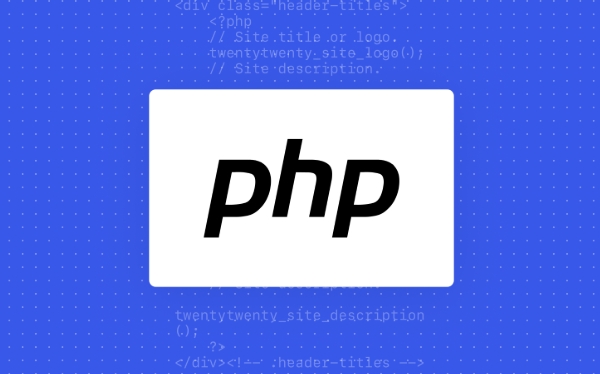When encountering the "undefined index" error in PHP, the solutions include: 1. Use isset() to determine whether the index exists and avoid directly accessing undefined keys; 2. Use array_key_exists() to check whether the key exists, which is suitable for situations where null values ??need to be distinguished; 3. Set default values ??for variables, such as using the empty merge operator?? to improve code simplicity; 4. Turn on error reports to help locate problems. These practices can effectively prevent errors caused by accessing non-existent array keys, and improve code robustness and maintainability.

It is actually a common problem to encounter the "undefined index" error in PHP, especially when processing form data or arrays. It's essentially because you're trying to access an array key (index) that doesn't exist. The key to solving this problem is: determine whether this key exists in the array in advance , and then use it.

Below are some practical methods and suggestions to help you solve this problem.
1. Use isset() to determine whether the index exists
This is the most common and recommended approach. Before accessing a key in the array, use isset() to check whether it exists:

if (isset($_GET['name'])) {
echo $_GET['name'];
} else {
echo 'Name does not exist';
}This avoids errors caused by direct access to undefined indexes.
Tips:
isset()will also returnfalsefor the value ofnull, so if you allownullvalue to exist, you can usearray_key_exists()mentioned below.
2. Use array_key_exists() to check whether the key exists
If you want to distinguish between "key does not exist" and "keys exist but value is null", you can use array_key_exists() :
if (array_key_exists('age', $_GET)) {
echo 'Age is:' . $_GET['age'];
} This function only checks whether the key exists, regardless of whether the value is null or not.
Note: This method does not check whether the variable itself is an array, so when you are not sure of the variable type, it is best to use
is_array()to make a judgment first.
3. Prevent errors from default values
Sometimes we don't need to make too much judgment, we just hope there is a default value when the index is not accessible. You can do this:
$name = isset($_POST['username']) ? $_POST['username'] : 'Default username';
Or in PHP 7 you can use the empty merge operator ?? , which is more concise:
$name = $_POST['username'] ?? 'Default username';
This way of writing not only clean code, but also effectively avoids errors.
4. Turn on the error report during debugging to view the specific location
If you don't know which line the error occurs, you can temporarily turn on the PHP error prompt function:
ini_set('display_errors', 1); error_reporting(E_ALL);
After adding these two lines, the page will display complete error information, including file name and line number, which is convenient for positioning issues.
Let’s summarize the commonly used methods:
- ? Use
isset()orarray_key_exists()to judge before accessing the array - ? Use empty merge operator
??to set default values - ? Error prompts to help debug when opening the development stage
- ? Do not directly access unjusted array keys
Basically these are the methods. Although the problem is not a big deal, it is easy to ignore in actual development, especially when novices are new to PHP form processing, they are prone to frequent pitfalls. As long as you develop good habits, this kind of mistake can be easily avoided.
The above is the detailed content of how to fix undefined index in PHP. For more information, please follow other related articles on the PHP Chinese website!

Hot AI Tools

Undress AI Tool
Undress images for free

Undresser.AI Undress
AI-powered app for creating realistic nude photos

AI Clothes Remover
Online AI tool for removing clothes from photos.

Clothoff.io
AI clothes remover

Video Face Swap
Swap faces in any video effortlessly with our completely free AI face swap tool!

Hot Article

Hot Tools

Notepad++7.3.1
Easy-to-use and free code editor

SublimeText3 Chinese version
Chinese version, very easy to use

Zend Studio 13.0.1
Powerful PHP integrated development environment

Dreamweaver CS6
Visual web development tools

SublimeText3 Mac version
God-level code editing software (SublimeText3)

Hot Topics
 What are some best practices for versioning a PHP-based API?
Jun 14, 2025 am 12:27 AM
What are some best practices for versioning a PHP-based API?
Jun 14, 2025 am 12:27 AM
ToversionaPHP-basedAPIeffectively,useURL-basedversioningforclarityandeaseofrouting,separateversionedcodetoavoidconflicts,deprecateoldversionswithclearcommunication,andconsidercustomheadersonlywhennecessary.StartbyplacingtheversionintheURL(e.g.,/api/v
 How do I implement authentication and authorization in PHP?
Jun 20, 2025 am 01:03 AM
How do I implement authentication and authorization in PHP?
Jun 20, 2025 am 01:03 AM
TosecurelyhandleauthenticationandauthorizationinPHP,followthesesteps:1.Alwayshashpasswordswithpassword_hash()andverifyusingpassword_verify(),usepreparedstatementstopreventSQLinjection,andstoreuserdatain$_SESSIONafterlogin.2.Implementrole-basedaccessc
 What are the differences between procedural and object-oriented programming paradigms in PHP?
Jun 14, 2025 am 12:25 AM
What are the differences between procedural and object-oriented programming paradigms in PHP?
Jun 14, 2025 am 12:25 AM
Proceduralandobject-orientedprogramming(OOP)inPHPdiffersignificantlyinstructure,reusability,anddatahandling.1.Proceduralprogrammingusesfunctionsorganizedsequentially,suitableforsmallscripts.2.OOPorganizescodeintoclassesandobjects,modelingreal-worlden
 What are weak references (WeakMap) in PHP, and when might they be useful?
Jun 14, 2025 am 12:25 AM
What are weak references (WeakMap) in PHP, and when might they be useful?
Jun 14, 2025 am 12:25 AM
PHPdoesnothaveabuilt-inWeakMapbutoffersWeakReferenceforsimilarfunctionality.1.WeakReferenceallowsholdingreferenceswithoutpreventinggarbagecollection.2.Itisusefulforcaching,eventlisteners,andmetadatawithoutaffectingobjectlifecycles.3.YoucansimulateaWe
 How can you handle file uploads securely in PHP?
Jun 19, 2025 am 01:05 AM
How can you handle file uploads securely in PHP?
Jun 19, 2025 am 01:05 AM
To safely handle file uploads in PHP, the core is to verify file types, rename files, and restrict permissions. 1. Use finfo_file() to check the real MIME type, and only specific types such as image/jpeg are allowed; 2. Use uniqid() to generate random file names and store them in non-Web root directory; 3. Limit file size through php.ini and HTML forms, and set directory permissions to 0755; 4. Use ClamAV to scan malware to enhance security. These steps effectively prevent security vulnerabilities and ensure that the file upload process is safe and reliable.
 What are the differences between == (loose comparison) and === (strict comparison) in PHP?
Jun 19, 2025 am 01:07 AM
What are the differences between == (loose comparison) and === (strict comparison) in PHP?
Jun 19, 2025 am 01:07 AM
In PHP, the main difference between == and == is the strictness of type checking. ==Type conversion will be performed before comparison, for example, 5=="5" returns true, and ===Request that the value and type are the same before true will be returned, for example, 5==="5" returns false. In usage scenarios, === is more secure and should be used first, and == is only used when type conversion is required.
 How can you interact with NoSQL databases (e.g., MongoDB, Redis) from PHP?
Jun 19, 2025 am 01:07 AM
How can you interact with NoSQL databases (e.g., MongoDB, Redis) from PHP?
Jun 19, 2025 am 01:07 AM
Yes, PHP can interact with NoSQL databases like MongoDB and Redis through specific extensions or libraries. First, use the MongoDBPHP driver (installed through PECL or Composer) to create client instances and operate databases and collections, supporting insertion, query, aggregation and other operations; second, use the Predis library or phpredis extension to connect to Redis, perform key-value settings and acquisitions, and recommend phpredis for high-performance scenarios, while Predis is convenient for rapid deployment; both are suitable for production environments and are well-documented.
 How do I perform arithmetic operations in PHP ( , -, *, /, %)?
Jun 19, 2025 pm 05:13 PM
How do I perform arithmetic operations in PHP ( , -, *, /, %)?
Jun 19, 2025 pm 05:13 PM
The methods of using basic mathematical operations in PHP are as follows: 1. Addition signs support integers and floating-point numbers, and can also be used for variables. String numbers will be automatically converted but not recommended to dependencies; 2. Subtraction signs use - signs, variables are the same, and type conversion is also applicable; 3. Multiplication signs use * signs, which are suitable for numbers and similar strings; 4. Division uses / signs, which need to avoid dividing by zero, and note that the result may be floating-point numbers; 5. Taking the modulus signs can be used to judge odd and even numbers, and when processing negative numbers, the remainder signs are consistent with the dividend. The key to using these operators correctly is to ensure that the data types are clear and the boundary situation is handled well.







